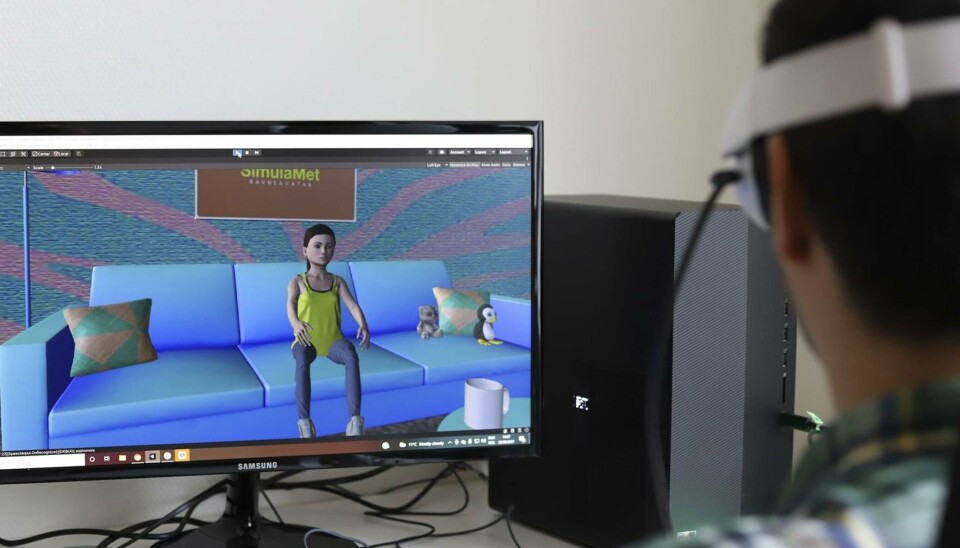THIS ARTICLE/PRESS RELEASE IS PAID FOR AND PRESENTED BY Oslo Metropolitan University - read more

Using AI to improve investigative interviews with children
Researchers and experts in the field of interviewing children are using artificial intelligence to develop new training methods for the police and the Child Welfare Services.
“We know a lot today about children’s capacity to talk about what they have experienced or have been subjected to, even at three years old,” says researcher and project manager Gunn Astrid Baugerud at OsloMet’s Faculty of Social Sciences.
She is head of the research project Professionals interviewing maltreated children supported via artificial avatars, which is developing a digital training programme that will eventually comprise sound, text and a child avatar. The child avatar will then enable professionals to practise interviewing children.
“When the right method is used in interviews, children provide more accurate information and often explain themselves in more detail,” Baugerud says. “There is a lot of empirical data about what works, but research in the field shows that the police and the Child Welfare Services are not able to use the recommended method to a sufficient extent. The gap between method and practice is too great."
She believes a training programme is needed to enable professionals to improve and maintain their skills.
“A persons’ skills become weaker once they are in the field, even if they have only just finished their training. Ideally, police and Child Welfare Services staff should start field training during their education years, and then take refresher and maintenance courses with an avatar,” the researcher continues.

How children are interviewed
“In Norway, we use the dialogical communication method, which is based on international research. The method is based on large empirical studies regarding what is deemed best practice, but the Norwegian model itself has not been evaluated," she says. “This is the standard procedure when you take further or continuing education in interviewing children and investigative conversations in the Child Welfare Services."
The dialogical communication method comprises several procedures where the goal is to get children to talk about difficult subjects in interviews.
The method was originally developed for the purpose of judicial examination. A separate version has been further developed for children who require additional assistance.
Interviewers should ask open and focused questions
“We then have the sequential interview method, which has been further developed from the dialogical communication method and is based on a model currently used in the USA. It is used with very young children, pre-school children, primary school children, adolescents and adults with disabilities, who require additional assistance and more time,” the researcher adds.
Sequential interviewing differs from the dialogical communication method in that it is considerably more time consuming and requires more thorough preparation.
Preparation includes interviews being adapted to the individual child, splitting the interview into sequences, and including regularly scheduled breaks.
“While a normal dialogical communication interview can take around an hour, a sequential interview with a five-year-old can take several hours because the child needs many breaks,” Baugerud points out.
When applying the best practice of interviewing, and the aim of an interview is for the child to speak freely without coaxing, a few main rules apply.
“The child must be allowed to speak freely, and words should not be put into their mouths, or information introduced that they have not themselves broached. You should ask open and focused questions. That means asking questions that follow up what the child has said,” Baugerud says.
Non-verbal communication
A lot of the communication between the interviewer and the child is non-verbal, which also requires professional training to communicate better.
“A lot of research has been conducted on the significance of non-verbal communication in recent years. You provide ‘social support’ to the child by establishing trust through body language and eye contact, or using the child’s name,” Baugerud explains.
Children quickly pick up on your expectations of the interview.
“Children are keen to please. So, if they get the impression that you are looking for a specific piece of information, then that in itself is a form of coaxing,” she says.
Developing a ‘digital child’
The research project’s partners in Australia have provided audio recordings of 2,000 mock interviews, i.e., interviews between an interviewer and an actor.
“Actors play the role of the child, and they have gradually become very skilled at adapting their answers based on the envisaged child’s age and the subject at hand. The conversations are recorded, and we are now working on transcribing them. We will be using this as the first step for building a chatbot,” Baugerud says.
The chatbot will then be trained by practising with the transcribed text and carrying out interviews through the computer. You may be familiar with chatbots from your online banking solutions, which is the same type of technology used here.
“The next step is to use anonymous transcriptions of approximately 1,000 real interviews, which we have access to through the Interviewing Children Project. Patterns will then begin to emerge out of what has and has not worked in the interviews. The chatbot should respond dynamically based on all the information it has been fed,” she continues.
They began testing a visual avatar before Christmas 2021.
“We will initially be using text and images. The avatars will reflect different personality traits, personality types and will be assigned different genders. They will reflect the emotions and language of a child,” Baugerud elaborates.
Artificial, but human
The avatar’s appearance will be anonymous and based on numerous images of different children fed to the artificial intelligence. This is so that the final image is not that of a real child.
“The goal is to end up with an avatar that can use text, sound and images, and has its own clear body language,” she says.
When using an avatar, non-verbal communication, such as body language and eye contact, can be an even greater challenge than communication involving sound or text.
“This is not something we are going to resolve right away. The most important thing is to establish the right method," Baugerud says.
But why is this something that requires training?
“Is it really that difficult to ask open questions? It is really difficult. When you sit down with a child and there is a lot at stake, stress levels rise, the child reacts in a way you had not expected, which increases the likelihood of the interview not being carried out in line with best practice," she says. “If you have prepared several recommended questions, there is a much greater likelihood of sticking to the method, particularly when in demanding situations."
A lot at stake
In Norway, the police often interview children who have been maltreated, or who are victims of violence.
There is a lot at stake in these interviews. Although many cases often require other evidence to secure a conviction, a child’s testimony is often the only evidence in abuse cases.
“The Child Welfare Services commonly has more opportunities to speak with these children than the police, and they are often involved at an earlier stage. However, if the Child Welfare Services does not carry out interviews in line with best practice, this could spoil the police’s chances in a potential criminal case,” she says.
Very young children are particularly vulnerable to being influenced during interviews.
“If a Child Welfare Services employee interviews a child and the child is influenced in one way or another, this could undermine the subsequent interview carried out by the police,” the researcher underlines.
What sort of training is required?
“A lot has changed in the police since the 1990s. There is a much greater focus on training regarding interviewing children, and greater acknowledgement of the fact that it requires training and a systematic approach,” Baugerud says.
The Norwegian Police University College runs ‘continuing professional development’ courses to improve and maintain skills used when interviewing children.
Admission is contingent on the applicant having completed at least ten recorded interviews. The Child Welfare Services also offers courses in the conversational method used by the police.
“The Norwegian police have come a long way in this field, also by international standards, but we still need to be more in line with the recommended method, and we believe there is still some way to go to achieving that," she says.
Training for Child Welfare Services staff generally takes place at the local offices, or under the Norwegian Directorate for Children, Youth and Family Affairs.
The training provided by both the police and the Child Welfare Services involves a lot of classroom tuition.
“Traditional classroom tuition is still the standard procedure with regards to both continuing and further education in the field. There are no digital training programmes,” concludes Baugerud.
Reference:
Baugerud et.al. 'Multimodal Virtual Avatars for Investigative Interviews with Children', Association for computing machinery, 2021. DOI:10.1145/3463944.3469269 Abstract.

This article/press release is paid for and presented by OsloMet
This content is created by Oslo Metropolitan University's communication staff, who use this platform to communicate science and share results from research with the public. Oslo Metropolitan University is one of more than 80 owners of ScienceNorway.no. Read more here.
See more content from OsloMet:
-
Researcher: Local government was key to managing the pandemic
-
"Norwegians practice a friendship version of a ‘one-night stand'"
-
"We need to talk about how we assess teacher students"
-
Cannabis use in Norway has increased: “Not everyone needs moral lectures or worried looks"
-
Many children with ADHD do not thrive at school
-
An out-of-control race: Why we fear artificial intelligence




































